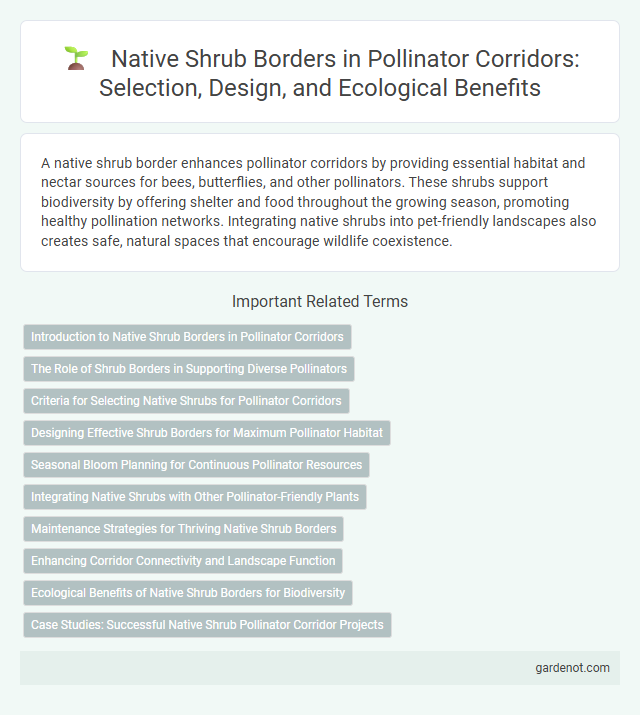A native shrub border enhances pollinator corridors by providing essential habitat and nectar sources for bees, butterflies, and other pollinators. These shrubs support biodiversity by offering shelter and food throughout the growing season, promoting healthy pollination networks. Integrating native shrubs into pet-friendly landscapes also creates safe, natural spaces that encourage wildlife coexistence.
Introduction to Native Shrub Borders in Pollinator Corridors
Native shrub borders play a crucial role in pollinator corridors by providing essential habitats and food sources for diverse pollinator species. These shrubs offer nectar, pollen, and shelter that support bees, butterflies, and other pollinators throughout their life cycles. Incorporating native shrub borders enhances biodiversity and strengthens ecosystem resilience within pollinator corridor landscapes.
The Role of Shrub Borders in Supporting Diverse Pollinators
Native shrub borders create vital habitats that sustain diverse pollinator populations by providing essential nectar sources, shelter, and breeding sites. Their dense foliage offers protection for native bees, butterflies, and hummingbirds, promoting pollinator diversity and ecosystem resilience. Establishing these borders enhances plant-pollinator interactions critical for biodiversity and agricultural productivity.
Criteria for Selecting Native Shrubs for Pollinator Corridors
Selecting native shrubs for pollinator corridors requires prioritizing species that provide nectar and pollen resources throughout multiple growing seasons to support diverse pollinator populations. Shrubs should exhibit strong adaptability to local soil and climate conditions, ensuring resilience and minimal maintenance while fostering native biodiversity. Selecting plants that bloom at staggered intervals alongside those hosting larval stages of pollinators enhances ecological connectivity and promotes sustainable habitat restoration.
Designing Effective Shrub Borders for Maximum Pollinator Habitat
Designing effective native shrub borders for pollinator corridors involves selecting diverse, native plant species that bloom sequentially to provide continuous nectar and pollen resources. Incorporating shrubs like Ceanothus, Arctostaphylos, and Vaccinium enhances habitat complexity, supporting diverse pollinator populations including bees, butterflies, and hummingbirds. Proper spacing, sun exposure, and soil conditions optimize shrub health and maximize foraging opportunities, promoting a resilient and thriving pollinator corridor.
Seasonal Bloom Planning for Continuous Pollinator Resources
Strategically selecting native shrubs with staggered blooming periods ensures a continuous supply of nectar and pollen throughout the growing season, supporting diverse pollinator species. Prioritizing species such as Ceanothus, Manzanita, and Toyon provides early spring to late fall floral resources, enhancing habitat resilience and pollinator health. This seasonal bloom planning maximizes pollinator corridor effectiveness by preventing resource gaps that could disrupt pollinator foraging patterns.
Integrating Native Shrubs with Other Pollinator-Friendly Plants
Integrating native shrubs with a variety of pollinator-friendly plants enhances biodiversity and provides essential habitat for bees, butterflies, and other pollinators throughout the growing season. Native shrubs offer structural support and continuous nectar sources, complementing flowering perennials and grasses that attract diverse pollinator species. This layered planting approach creates resilient pollinator corridors that boost ecosystem health and improve pollination services for surrounding agriculture and wild plants.
Maintenance Strategies for Thriving Native Shrub Borders
Maintaining native shrub borders in pollinator corridors requires regular pruning to promote healthy growth and prevent overcrowding, ensuring optimal light penetration and air circulation. Mulching conserves soil moisture and suppresses weeds, while periodic soil testing guides targeted nutrient management for robust shrub development. Integrated pest management techniques minimize chemical use, protecting pollinator populations and supporting a resilient ecosystem.
Enhancing Corridor Connectivity and Landscape Function
Native shrub borders significantly enhance pollinator corridor connectivity by providing continuous habitat and food resources essential for pollinator movement. These dense, diverse shrub layers improve landscape function by serving as natural windbreaks, moisture retainers, and shelter, facilitating pollinator survival across fragmented habitats. Incorporating native shrubs fosters ecological resilience and supports pollinator biodiversity by linking isolated patches and promoting genetic exchange among populations.
Ecological Benefits of Native Shrub Borders for Biodiversity
Native shrub borders provide essential habitats and food sources for a wide range of pollinators and wildlife, enhancing local biodiversity. These shrub borders support ecological networks by offering shelter, nesting sites, and abundant nectar and pollen resources, which contribute to healthier pollinator populations. Integrating native shrubs within pollinator corridors strengthens ecosystem resilience and promotes sustainable biodiversity conservation.
Case Studies: Successful Native Shrub Pollinator Corridor Projects
Case studies of native shrub pollinator corridors demonstrate significant increases in local biodiversity, with species such as Aronia melanocarpa and Ceanothus integerrimus attracting diverse bee populations. These projects reveal improved pollination rates in adjacent agricultural lands, enhancing crop yields by up to 30%. Successful implementations in California and the Midwest highlight strategic plant selections tailored to native pollinator preferences and seasonal bloom cycles.
Native shrub border Infographic

 gardenot.com
gardenot.com